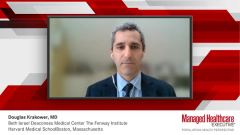
Educating Patients About HIV PrEP
Recommendations when talking with patients about goals of HIV PrEP and ensuring a patient-centered approach to care.
Episodes in this series

Moti Ramgopal, MD, FACP, FIDSA: The goal of patients being on or eligible for PrEP [pre-exposure prophylaxis] is you want to engage them, to get them into care. And in that period, create a level of awareness of their risk behavior, understanding what the risk implication of HIV looks like, what a cure looks like if they do acquire HIV. I think now in the year 2021, when we don’t see the images like we saw 10 or 20 years ago, the impact on the new generation, the younger generation, is that HIV is not even something to think about. I think that’s where we need to be aggressive in engaging that patient.
When a patient comes in, we’ll have that conversation. And then it’s a whole group effort, meaning that I’ll have a pharmacist looking at the medication, insurance charges, look at the mental health of that patient. Because a lot of times, high-risk behavior will go along with substance abuse, use of drugs. And that’s an important component to look at in these patients. The patient-centered care is about understanding that individual and allowing that individual now to have access to clinical care in the sense that here’s a mental health worker, here’s a pharmacist, here’s a social worker. And all of these components need to be there once the patient is engaged to be in care.
What does patient-centered care look like in our practice? For one, I’ve actually hired younger health care providers, my physician assistant, my nurse practitioners. And why did I do that? Because as an older and aging physician, I recognize that my communication skills with the younger generation may be a little different, and I need someone who can have that conversation with someone in their 20s and the teenage years, and a little older, and have that conversation easier than I probably can. I think it’s an important component to recognize that.
It’s also important to recognize that the high-risk individual may be transgender, may be cisgender, may culturally have stigma related to coming into care. These are little pieces that you have to address from very early, have to feel that level of comfort. From the time that person walks into your office, you’ll have a front office person, have communication, and may have a checkout person. So you have to have a clinic that has significant amount of LGBTQ [lesbian, gay, bisexual, transgender, queer] providers involved and personnel involved, to make those patients feel comfortable that the care they’re going to receive is at a cultural level,destigmatized care. Because you hear patients say they’re taking a pill called Truvada. They may wonder is it for HIV, or is it for hepatitis, or is it for prevention of HIV? When you think of that, patients sometimes need to understand that no, it is for PrEP, and it is also for hepatitis C, or also for HIV. These are pieces that you have to really educate patients about.
Sometimes I will see a patient, for example, presenting with emotional issues at home, challenges at home with their parents accepting their personality, accepting their gender issues. I have someone in the office, maybe a mental health worker, maybe someone who has had similar issues, to sit to that person and address those concerns. And then they need to realize that the risk of transmission of HIV is high, but also there are substance abuse questions, mental health issue questions. We wrap all of this into patient care as a whole formula, rather than separating them individually.
Transcript edited for clarity.
Newsletter
Get the latest industry news, event updates, and more from Managed healthcare Executive.

























































